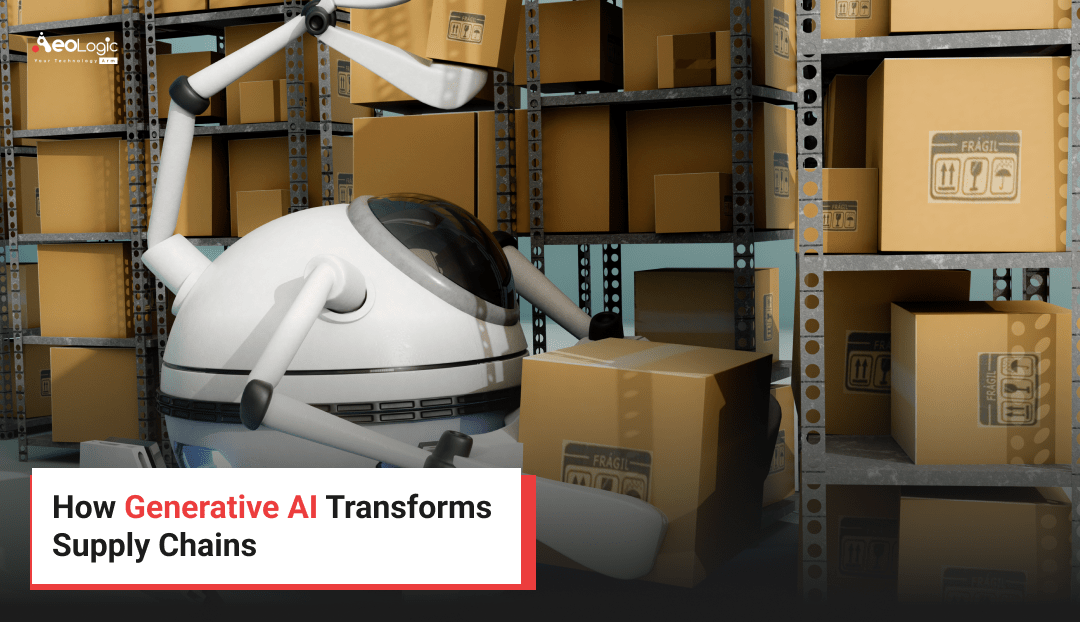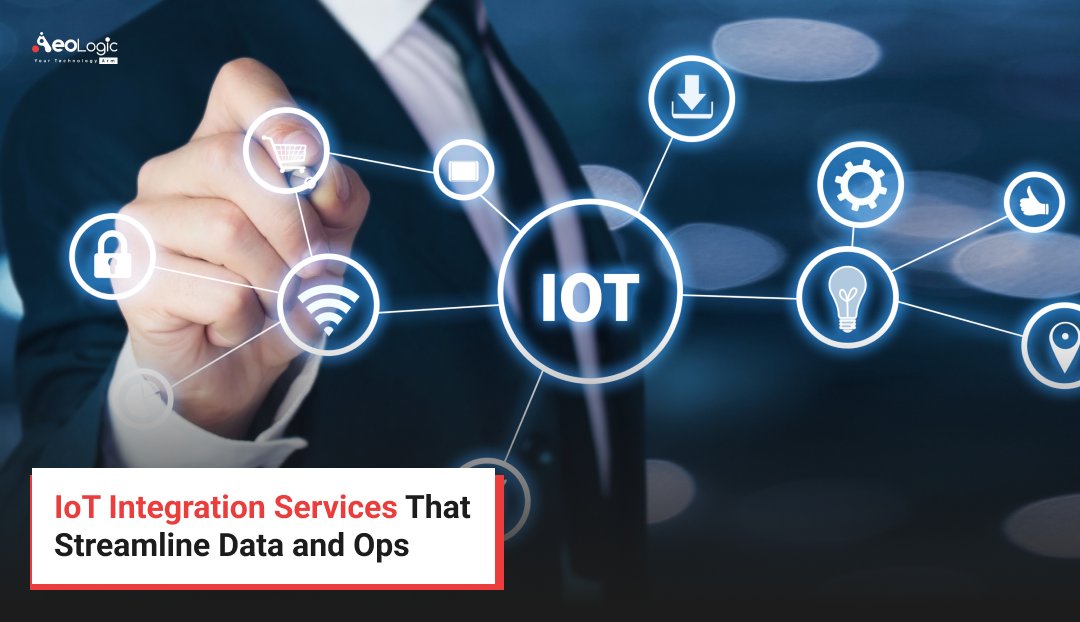Managing a modern supply chain is like walking a tightrope in a windstorm. One small disruption—whether a customs delay, a sudden demand spike, or a lost shipment—can send ripple effects across the entire operation. In today’s economy, where customer expectations keep rising and global shocks are frequent, supply chains need more than spreadsheets and gut instinct. They need strategic foresight, speed, and resilience. That’s where generative AI in supply chains comes in.
Generative AI is not just another tech buzzword. It’s a tool that brings predictive intelligence and creativity into operations, helping businesses build smarter, more responsive, and cost-efficient supply chains. This blog explores how generative AI works, where it drives impact, and what manufacturers and logistics leaders must consider to implement it successfully.
1. What Is Generative AI and How It’s Different from Traditional AI
Think of traditional AI as a highly skilled analyst. It studies past data, identifies trends, and helps with forecasting. It can predict how much inventory you’ll need next quarter based on past patterns.
Generative AI, on the other hand, acts more like a strategist. It doesn’t just analyze the past — it simulates future scenarios, recommends actions, and helps businesses proactively shape outcomes. Instead of asking, “What happened?” or “What will happen?”, it asks, “What should we do about it?”
That shift—from analysis to generation—makes it ideal for dynamic, high-stakes environments like supply chains. It’s the difference between reacting to change and engineering it.
2. Key Areas Where Generative AI Impacts the Supply Chain
A. Smarter Inventory Management
Overstocking ties up cash in unsold goods. Understocking leads to missed sales and unhappy customers. Generative AI balances this by simulating various demand scenarios using live market data, historical trends, seasonal cycles, and even social media signals.
Retailers, manufacturers, and wholesalers alike use AI to identify the exact reorder points, ideal safety stock levels, and optimal supplier combinations.
Example: A fashion retailer used generative AI to refine holiday season inventory, reducing overstock by 20% while maintaining 100% order fulfillment.
B. Autonomous Logistics and Route Optimization
Logistics is plagued by rising fuel costs, traffic unpredictability, and inefficient routing. Generative AI designs optimal delivery paths by simulating thousands of routes, factoring in fuel prices, traffic, weather, customs delays, and even driver behavior.
Beyond delivery, AI also forecasts maintenance needs for vehicles and predicts delays based on external data such as weather alerts or geopolitical risks.
Example: A courier company reduced fuel consumption by 15% by adopting AI-generated last-mile routes, while simultaneously improving delivery time windows by 22%.
C. Warehouse Automation and Robotics
In busy warehouses, pick-and-pack inefficiencies cost time and money. Generative AI models the ideal layout, worker movement, robotic coordination, and storage allocation to optimize every square foot.
Real-time simulation of foot traffic, peak order times, and SKU velocity lets companies reconfigure shelves and staff shifts dynamically.
Example: Amazon’s AI-driven warehouses report 25% higher fulfillment efficiency due to smarter task sequencing and storage placement.
D. Risk Management and Resilience Building
From natural disasters to labor strikes, disruptions are costly. Generative AI in supply chains builds simulations to detect vulnerabilities in advance and offers preemptive mitigation strategies. It also maps out alternate suppliers and logistics routes before the need arises.
Example: A global electronics brand averted $10 million in losses by rerouting supplier dependencies just before a region-wide flood. Their AI system had flagged risk levels two weeks in advance.
E. Procurement and Supplier Management
AI doesn’t just help pick suppliers—it helps evaluate their stability, ESG compliance, risk exposure, and delivery reliability. It simulates supply scenarios for multiple partners and recommends diversification or renegotiation.
Procurement departments use this insight to negotiate better terms, shift from single-source reliance, and detect fraud or risk patterns.
3. Cost Efficiency and Productivity Gains
Generative AI drives measurable savings:
- Inventory: Reduces holding costs by 10–30%
- Logistics: Cuts delivery/fuel costs by 15–25%
- Procurement: Improves supplier selection, slashing costs by 5–20%
- Labor: Boosts warehouse productivity by 20–40%
- Risk Management: Prevents millions in disruption-related losses
It also reduces human error and decision lag by automating data collection, scenario generation, and outcome forecasting.
4. Real-World Success Stories
Coca-Cola: Facing global inconsistencies in can production and seasonal demand shifts, Coca-Cola deployed generative AI models to predict demand drivers. The result? An 18% drop in production costs and faster order fulfillment.
DHL: To solve punctuality and fuel inefficiencies, DHL used AI to generate traffic-aware routing maps. The change led to a 20% fuel burn reduction and higher on-time deliveries.
Unilever: Amid geopolitical disruptions, Unilever used generative AI to reconfigure sourcing networks, improving flexibility and preserving trade routes.
Maersk: The shipping giant uses generative AI to simulate global freight disruptions, improving transshipment routing and container repositioning efficiency.
Walmart: AI models help Walmart predict regional demand swings and adjust last-mile delivery staffing accordingly.
5. Challenges and Future Trends
Despite its promise, generative AI faces a few hurdles:
- Data Quality: Inconsistent or messy data reduces model accuracy.
- Legacy Systems: Older platforms may not support modern AI integrations.
- Bias & Ethics: AI systems can perpetuate biases from training data.
- Interpretability: Many executives hesitate to trust “black box” decisions.
And yet, innovation is accelerating. Some rising trends:
- Hyper-personalized Logistics: Real-time recommendations based on end-customer behavior
- Blockchain Integration: Combined with AI for traceable, secure supplier contracts
- Cognitive Supply Chains: AI systems that understand intent and react accordingly
- Self-Healing Networks: Autonomous rerouting of orders and stock when disruptions strike
6. Implementation Roadmap
Step 1: Define Objectives
Set clear KPIs (e.g., reduce stockouts by 25%, increase order accuracy by 10%)
Step 2: Audit Data Ecosystem
Ensure access to clean, connected data from ERP, CRM, logistics partners, and supplier portals.
Step 3: Select the Right Stack
Compare providers like Azure OpenAI, Google Vertex, and AWS Bedrock. Consider integration with SAP or Oracle SCM.
Step 4: Design a Pilot Use Case
Choose a use case that shows ROI fast—such as inventory planning or route design in one market.
Step 5: Build Cross-Functional Teams
Involve operations, IT, finance, and procurement early. AI adoption must not sit in silos.
Step 6: Rollout & Train
Deploy and integrate the system across functions. Train users to trust AI outputs but verify them.
Step 7: Optimize Continuously
Update models regularly with feedback loops and fresh data. Monitor business KPIs and system behavior.
7. Ethical and Governance Considerations
- Data Privacy: Secure all personally identifiable and business-sensitive data. Adhere to regulations like GDPR.
- Explainability: Choose platforms that provide transparency behind AI recommendations.
- Inclusivity: Ensure AI does not exclude small vendors or low-income regions from supply participation.
- Workforce Impact: Offer retraining for employees whose tasks are automated or redefined.
- Governance Boards: Form internal review boards to evaluate model fairness, accuracy, and policy compliance.
Ethics aren’t optional—they’re essential to build trust and secure stakeholder buy-in.
8. The Future of Generative AI in Supply Chains
The future will feature:
- AI-planned supply chains that adjust in real-time without human intervention
- Digital twins for entire supply networks, enabling scenario simulation
- Smart contracts managed by AI for real-time pricing and compliance
- AI copilots assisting planners in real-time with voice or visual input
- Integrated planning tools combining demand sensing, order planning, and supplier scorecards
As AI gets more intelligent and accessible, the gap between proactive and reactive supply chains will widen. Early adopters will set the new performance benchmarks.
9. Final Thoughts
We’ve entered a new era of proactive, intelligent by Generative AI in supply chains. The ability to simulate scenarios, optimize logistics, and navigate risks in real time is transforming how global commerce operates.
To thrive in the face of volatility, companies must move fast — starting with pilots, aligning data, and preparing their people. The payoff? Leaner costs, greater resilience, and a future-ready business.
The best time to start was yesterday. The next best time is now.

Passionate about breaking down complex tech into simple ideas. Covers everything from AI and software development to gadgets and emerging tech trends.






